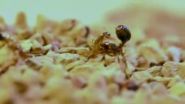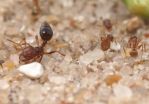(Press-News.org) VIDEO:
In this video, a fire ant dabs venom on an attacking crazy ant. The crazy ant coats itself with formic acid to neutralize the venom, a discovery made by University...
Click here for more information.
AUSTIN, Texas — Invasive "crazy ants" are rapidly displacing fire ants in areas across the southeastern U.S. by secreting a compound that neutralizes fire ant venom, according to a University of Texas at Austin study published this week in the journal Science Express. It's the first known example of an insect with the ability to detoxify another insect's venom.
The crazy ant invasion is the latest in a series of ant invasions from the southern hemisphere and, like its predecessors, will likely have dramatic effects on the region's ecosystems.
Known for their painful stings on humans and other animals, fire ants dominate most ant species by dabbing them with powerful, usually fatal venom. A topical insecticide, the venom is two to three times as toxic as DDT on a per weight basis.
When a crazy ant is smeared with the venom, however, it begins an elaborate detoxification procedure, described for the first time in this study. The exposed crazy ant secretes formic acid from a specialized gland at the tip of its abdomen, transfers it to its mouth and then smears it on its body. (Watch a video of the process: http://youtu.be/CaAq25JQM4k.)
In lab experiments, exposed crazy ants that were allowed to detoxify themselves had a 98 percent survival rate. This chemical counter-weapon makes crazy ants nearly invincible in skirmishes with fire ants over food resources and nesting sites.
"As this plays out, unless something new and different happens, crazy ants are going to displace fire ants from much of the southeastern U.S. and become the new ecologically dominant invasive ant species," said Ed LeBrun, a research associate with the Texas invasive species research program at the Brackenridge Field Laboratory in UT Austin's College of Natural Sciences.
Last year, the researchers reported that where crazy ants take hold, the numbers and types of arthropods — insects, spiders, centipedes and crustaceans — decrease, which is likely to have ripple effects on ecosystems by reducing food sources for birds, reptiles and other animals. They also nest in people's homes and damage electrical equipment.
LeBrun described watching a battle for food between red fire ants and crazy ants along the boundary between their two populations at a Texas field site. The fire ants found a dead cricket first and were guarding it in large numbers. Usually when fire ants amass around a food resource, other ants stay clear for fear of their deadly venom.
"The crazy ants charged into the fire ants, spraying venom," said LeBrun. "When the crazy ants were dabbed with fire ant venom, they would go off and do this odd behavior where they would curl up their gaster [an ant's modified abdomen] and touch their mouths."
It was then that LeBrun first suspected the ants were somehow detoxifying the fire ant venom. Experiments back at the Brackenridge Field Laboratory in Austin helped him and his colleagues identify the detoxification agent and measure its effectiveness.
To test the effectiveness of the formic acid, researchers sealed the glands of crazy ants with nail polish and put them in vials with red fire ants. Without the ability to apply the detoxifying compound to themselves, about half of the crazy ants dabbed with fire ant venom died. Among a control group of crazy ants with unsealed glands, on the other hand, 98 percent survived.
Crazy ants and red fire ants are both native to northern Argentina and southern Brazil, where their ranges have overlapped for a very long time. The researchers suggest this newly discovered detoxification behavior is the result of an ancient evolutionary arms race.
It's still not clear how formic acid renders imported fire ant venom nontoxic. One possibility is that it prevents the venom from penetrating the outer layers of a crazy ant's exoskeleton.
Apart from human intervention, said LeBrun, the only thing stopping the relentless march of the crazy ants will be natural factors, such as arid soils or severe freezes, that will be too harsh for them to survive. Like the fire ants before them, their range will ultimately be determined by geology and climate.
There is one bright spot for humans. Unlike fire ants, colonies of crazy ants spread very slowly — about 600 feet per year. The only way they can spread long distances is when transported by people in potted plants and recreational vehicles. LeBrun suggested that people not buy plants if they see ants nesting in the pots and that if they live in areas already invaded by crazy ants, they check for stowaways when they move homes or travel long distance.
"If you have an RV, inspect the campgrounds you visit before parking for the night," said LeBrun. "If you live in infested areas, don't store food in your vehicles and consider treating your camper with insecticides several days before a trip. Consult with a pest control professional as to the best products to use. Not storing food in any vehicle parked in an infested area is also a good idea."
INFORMATION:
LeBrun's co-authors are Nathan Jones and Lawrence Gilbert, both at The University of Texas at Austin.
Funding was provided by the Helen C. Kleberg and Robert J. Kleberg Jr. Foundation, and the Lee and Ramona Bass Foundation.
Media Relations Contacts:
Marc Airhart
512-232-1066
mairhart@austin.utexas.edu
Steve Franklin
512-232-3692
sefranklin@austin.utexas.edu
Crazy ants dominate fire ants by neutralizing their venom
2014-02-14
ELSE PRESS RELEASES FROM THIS DATE:
Cat parasite found in western Arctic Beluga deemed infectious
2014-02-14
University of British Columbia scientists have found for the first time an infectious form of
the cat parasite Toxoplasma gondii in western Arctic Beluga, prompting a health advisory to the
Inuit people who eat whale meat.
The same team also discovered a new strain of the
parasite Sarcocystis, previously sequestered in the icy north, that is responsible for killing
406 grey seals in the north Atlantic in 2012.
Presenting their findings today at the 2014
Annual Meeting of the American Association for the Advancement of Science (AAAS), Michael Grigg
and ...
NOAA researcher says Arctic marine mammals are ecosystem sentinels
2014-02-14
As the Arctic continues to see dramatic declines in seasonal sea ice, warming temperatures and increased storminess, the responses of marine mammals can provide clues to how the ecosystem is responding to these physical drivers.
Seals, walruses and polar bears rely on seasonal sea ice for habitat and must adapt to the sudden loss of ice, while migratory species such as whales appear to be finding new prey, altering migration timing and moving to new habitats.
"Marine mammals can act as ecosystem sentinels because they respond to climate change through shifts in distribution, ...
Stanford psychologist shows why talking to kids really matters
2014-02-14
Fifty years of research has revealed the sad truth that the children of lower-income,
less-educated parents typically enter school with poorer language skills than their more
privileged counterparts. By some measures, 5-year-old children of lower socioeconomic status
(SES) score two years behind on standardized language development tests by the time they enter
school.
In recent years, Anne Fernald, a psychology professor at Stanford University, has
conducted experiments revealing that the language gap between rich and poor children emerges
during infancy. ...
For understanding family structure to trauma: New technology is yielding bigger data
2014-02-14
Austin - February 13, 2014 - Social media can do more than just entertain us and keep us connected. It also can help scientists better understand human behavior and social dynamics. The volume of data created through new technology and social media such as Facebook and Twitter is lending insight into everything from mapping modern family dynamics to predicting postpartum depression.
"By analyzing different types of social media, search terms, or even blogs, we are able to capture people's thinking, communication patterns, health, beliefs, prejudices, group behaviors – ...
Genetic chip will help salmon farmers breed better fish
2014-02-14
Atlantic salmon production could be boosted by a new technology that will help select the best fish for breeding.
The development will enable salmon breeders to improve the quality of their stock and its resistance to disease.
A chip loaded with hundreds of thousands of pieces of DNA – each holding a fragment of the salmon's genetic code – will allow breeders to detect fish with the best genes.
It does so by detecting variations in the genetic code of each individual fish – known as single nucleotide polymorphisms (SNPs). These variations make it possible to identify ...
Discovery may help to explain mystery of 'missing' genetic risk
2014-02-14
A new study could help to answer an important riddle in our understanding of genetics: why research to look for the genetic causes of common diseases has failed to explain more than a fraction of the heritable risk of developing them.
Susceptibility to common diseases is believed to arise through a combination of many common genetic variants that individually slightly increase the risk of disease, plus a smaller number of rare mutations that often carry far greater risk.
However, even when their effects are added together, the genetic variants so far linked to common ...
Mixed genes
2014-02-14
This news release is available in German. When individuals from different groups interbreed, their offspring's DNA becomes a mixture of the DNA from each admixing group. Pieces of this DNA are then passed along through subsequent generations, carrying on all the way to the present day. Researchers from the Max Planck Institute for Evolutionary Anthropology in Leipzig, Germany, Oxford University and University College London (UCL) have now produced a global map detailing the genetic histories of 95 different populations across the world, spanning the last four millennia.
The ...
Study highlights indigenous response to natural disaster
2014-02-14
DENVER (Feb. 13, 2014) – When a tsunami struck American Samoa in 2009, indigenous institutions on the islands provided effective disaster relief that could help federal emergency managers in similar communities nationwide, according to a study from the University of Colorado Denver and the University of Hawaii at Manoa.
The study found that following the tsunami, residents of the remote U.S. territory in the South Pacific relied on Fa'aSamoa or The Samoan Way, an umbrella term incorporating a variety of traditional institutions governing the lives of its citizens.
"We ...
Berkeley Lab researchers at AAAS 2014
2014-02-14
Can more accurate climate models help us understand extreme weather events? Can we use
synthetic biology to create better biofuels? These questions, and the ongoing search for Dark
Matter and better photovoltaic materials, are just some of the presentations by Lawrence
Berkeley National Lab researchers at this year's AAAS meeting. Here's a quick look at Berkeley
Lab@AAAS:
Friday, Feb. 14
1:00-2:30
Opportunities for New Materials in
Photovoltaics (Toronto Room, Hyatt Regency)
Ramamoorthy Ramesh
The
Department of Energy's ...
Superconductivity in orbit: Scientists find new path to loss-free electricity
2014-02-14
UPTON, NY—Armed with just the right atomic arrangements, superconductors allow electricity to flow without loss and radically enhance energy generation, delivery, and storage. Scientists tweak these superconductor recipes by swapping out elements or manipulating the valence electrons in an atom's outermost orbital shell to strike the perfect conductive balance. Most high-temperature superconductors contain atoms with only one orbital impacting performance—but what about mixing those elements with more complex configurations?
Now, researchers at the U.S. Department of ...




